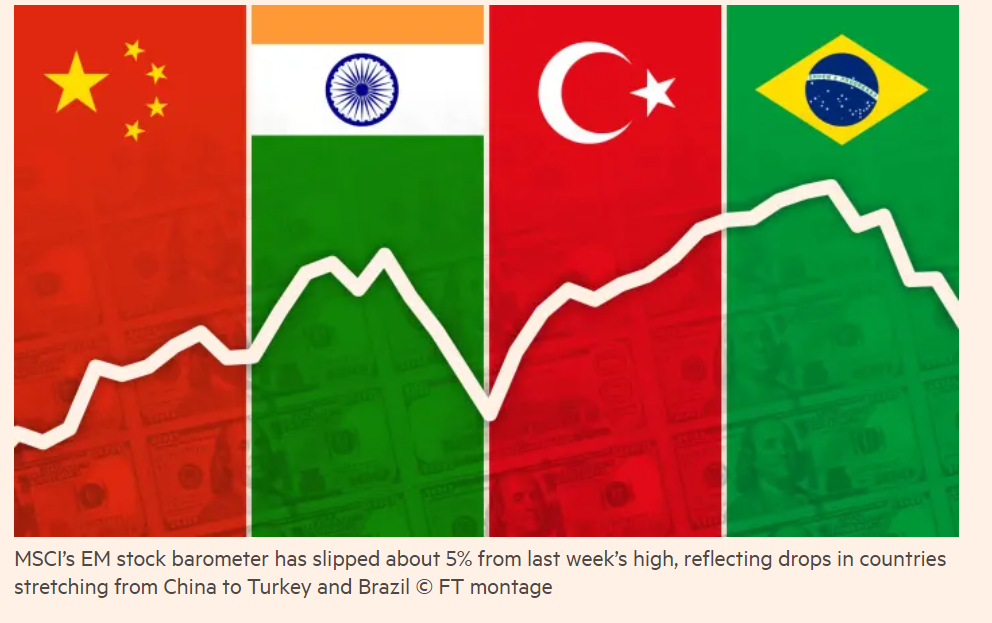On Thursday, global benchmark US 10-year government bond yield hit 2.03%, a 4 year high. Yet, Emerging Market stocks soared the same day, on Central Bank rate hikes and prospects of robust GDP growth. Is this response rational? Or, should EM investors fear Fed tightening and China’s wobbly real estate-cum-construction industry? Most experts wave away major concerns to advise their clients to increase their positions in EM assets, though leaving aside a deep global USD liquidity pool and valuations being cheap vs. US, the asset class offers few exciting stories.
Desmond Lachman, a former deputy director in the IMF’s policy development and review department, and currently a senior fellow at the American Enterprise Institute, points to pitfalls of EM optimism.
Two ill winds of change are blowing in the global economy that do not bode well for the emerging market economic outlook in 2022.
In the US, the Federal Reserve is being forced to slam on the monetary policy brakes to get the inflation genie back into the bottle.
In China, the world’s second-largest economy and its main engine of economic growth, there are increasing signs that its property- and credit-led economic growth model is running out of steam.
In 2021, while the Covid-19 pandemic was still adversely affecting their economies, emerging markets enjoyed a favorable external economic environment.
Russia Ukraine Conflict: Turkey Is Collateral Damage
The ultra-easy monetary policies by the world’s major central banks in general, and by the Fed in particular, kept global interest rates at record low levels and kept capital flowing freely to the emerging market economies.
At the same time, the strong US and Chinese economic recoveries kept international commodity prices very well bid and provided ample export markets for the emerging market economies.
With US inflation having now surged to a 40-year high of more than 7%, the days of ultra-easy global liquidity would seem to be coming to an end. Indeed, at its last meeting, the Fed announced it would end its aggressive bond-buying programme in March. It will be doing so with a view to paving the way for a series of interest rate hikes to allow the Fed to regain control over inflation.
Nosebleed levels
While the world is suffering from an “everything” asset price and credit market bubble, a new round of Fed interest rate hikes poses an especially large risk to the emerging market economies.
With US equity valuations at nosebleed levels experienced only once before in the last century and with US housing prices now above those before the 2006 housing market bust, there is every prospect that higher US interest rates will be the trigger that bursts those bubbles.
That in turn could lead to a hard US economic landing and to a strong reversal in capital flows from the emerging market economies.
Unfortunately for the emerging market economies, the prospective slowing in the US economy will be occurring at the very time that China is now experiencing acute problems in its property sector.
Those problems have been underlined by the recent default of Evergrande, the world’s largest property developer, as well as by a series of credit measures taken by the Chinese government to deal with the country’s excessive housing market supply.
With the Chinese property sector accounting for as much as 30% of its economy and a very large proportion of Chinese household wealth, any adjustment in that sector must be expected to put the Chinese economy on a much slower economic growth path than it has experienced to date.
This would especially be the case while President Xi Jinping’s common prosperity programme appears to be reversing many of Deng Xiaoping’s economic reforms that laid the basis for the Chinese economic miracle.
Any appreciable Chinese economic slowdown could be particularly problematic for the emerging market economies. Not only is China the world’s largest international commodity consumer, it is also the primary export market for its Asian economic partners.
It used to be said that when the US economy sneezes the rest of the world economy catches pneumonia. In the year ahead, we need to brace ourselves for finding out what happens when both the US and the Chinese economies, which together account for about 40% of the world economy, sneeze simultaneously.
Follow our English language YouTube videos @ REAL TURKEY:
https://www.youtube.com/channel/UCKpFJB4GFiNkhmpVZQ_d9Rg
And content at Twitter: @AtillaEng
